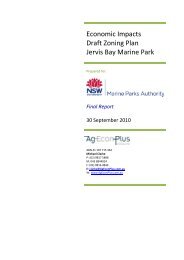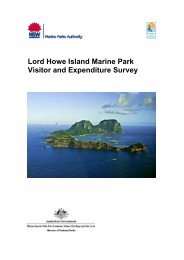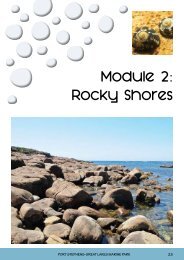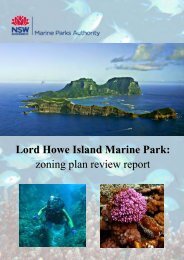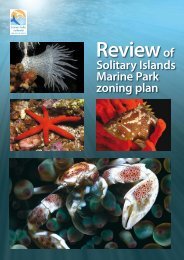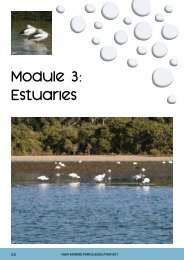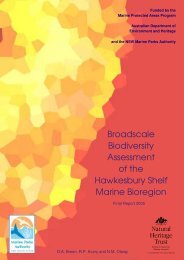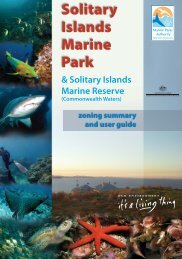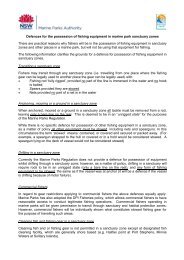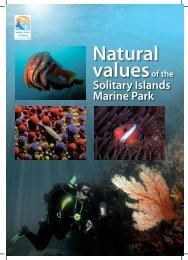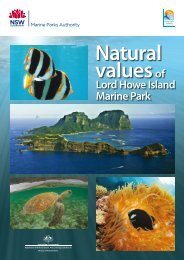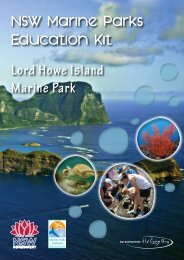Research Project Summaries 2002-2009 - Marine Parks Authority ...
Research Project Summaries 2002-2009 - Marine Parks Authority ...
Research Project Summaries 2002-2009 - Marine Parks Authority ...
Create successful ePaper yourself
Turn your PDF publications into a flip-book with our unique Google optimized e-Paper software.
Different types of ASUs supported different levels of species assemblages andcommunities. Unique recruitment to each type of ASU made each valuable todetermine regional amphipod biodiversity, with five types providing an optimum solution(Hughes 2007). Amphipods readily colonised ASUs, which sampled more amphipodfauna than the general collection of natural habitats. Assemblages recruiting to thesampling package were strongly representative of the local and regional species poolwhen compared to master lists compiled from all available records. While significantdifferences were found between types of ASUs, recruiting assemblages more closelyreflected location-specific differences when compared across the four island locations.Surrogates for biodiversityReliable indicator taxa need to be developed to assess effectiveness of marineconservation monitoring programs and management actions. Using the rocky shores ofthe marine park as a model, macroinvertebrates were evaluated to determine whichtaxa:best reflected ecological patterns of the broader intertidal communitywere able to accurately predict species richness of assemblages of entireheadlands (Smith 2005)Both molluscs and crustaceans showed high levels of correlation with overall speciesrichness. However, molluscs, particularly prosobranchs, most closely reflected patternsin community data and provided the most accurate predictions of species richness atthe headland scale. Molluscs offer considerable potential time savings, with reductionsin field time by up to 40%, as well as reduced need for extensive taxonomic knowledgeof other invertebrate groups. They are widespread and easily sampled, with stabletaxonomy and well-known ecology relative to other marine invertebrate taxa. Their useas surrogates of biodiversity has great potential for future marine conservation studies.To test this, surveys of death assemblages (dead shells) were conducted on 10headlands. Species lists were analysed to determine:average taxonomic distinctness – the degree to which species in a sample arerelatedvariation in taxonomic distinctness – the evenness of distribution of speciesacross higher taxonomic levelsThese biodiversity indices were then compared with equivalent measures determinedfrom a regional species list (Smith 2004).Five headlands returned average taxonomic distinctness. Progressive, random poolingof data further indicated that a species list compiled from any three or more headlandsfully represented regional biodiversity determined by this index In contrast, only threeheadlands showed variation in taxonomic distinctness, and progressive pooling acrossheadlands did not improve the outcome. This was mainly due to over-representation ofsome gastropod families, and under-representation of most bivalve families in deathassemblages at most sites. The practical implications are that at least three headlandsneed to be surveyed to obtain representative estimates of average taxonomicdistinctness of molluscs in the region. The unevenness of taxonomic representationand, in particular, the under-sampling of bivalves, further suggests that data collectedfrom paired headland–beach surveys may be more representative of regional molluscbiodiversity (Smith and Harrison 2006).In a further experiment, community structure was compared between two dominantnatural algal habitats (kelp holdfasts and algal turf) and ASUs (nests of pan scourers)Solitary Island and Jervis Bay <strong>Marine</strong> <strong>Parks</strong> <strong>Research</strong> <strong>Project</strong>s <strong>Summaries</strong> <strong>2002</strong>–<strong>2009</strong> 11



